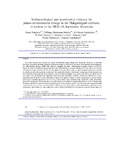Sedimentological and geochemical evidence for palaeo-environmental change in the Makgadikgadi subbasin, in relation to the MOZ rift depression, Botswana
Date
2005Author
Ringrose, S.
Huntsman-Mapila, P.
Kampunzu, A.B.
Downey, W.
Coetzee, S.
Vink, B.W.
Matheson, W.
Vanderpost, C.
Publisher
Elsevier www.elsevier.com/locate/palaeoType
Published ArticleMetadata
Show full item recordAbstract
This work considers new evidence for palaeo environmental change taking place during the Pleistocene in northern Botswana. Duricrusted strandlines along the northeastern margin of Sua Pan provide palaeo-environmental data pertaining to
the Makgadikgadi subbasin (MSB) with inferences regarding the larger Makgadikgadi–Okavango–Zambezi (MOZ) rift
depression. Field, XRD and geochemical data show that MSB strandlines comprise calcretes (LU1 type), MgO-rich calcretes
with silica (LU2 type), sil-calcrete (LU3 type) and silcrete (LU4 type). Early freshwater episodes appear to have been followed by calcrete-dominated drying phases interspersed with repeated silcretisation. Calcretisation through pan littoral sediments may have been both biogenically and environmentally induced. Calcite precipitation was in part controlled by the Mg/Ca ratio of pore water in the pan littoral zone suggesting closed basin type evaporative conditions, which were followed by a major desiccation interval. Phases of silcrete precipitation appear to be related to periods when the geochemistry of the lake littoral more closely resembled present-day Na–CO3–SO4–Cl-type brines. Silica saturated acidic, moderately saline groundwater
preceded Si precipitation which took place as the pH reduced. Si mobilisation occurred (inter alia) as a result of quartz grain
dissolution enhanced by diatoms, bacteria and algal growth in the moist pan littoral. SiO2-rich pore waters migrated through
cracked and desiccated calcrete into areas of lower salinity and lower pH resulting in preferential calcite removal and silcrete
precipitation. Approximate TL dates imply that exposed littoral sand underwent calcretisation during the drying phases of extensive palaeo-lakes which occurred prior to 110 ka, 80–90 ka and 41–43 ka. These wet periods compare fairly well with
Vostok core chronologies for southern Africa.

